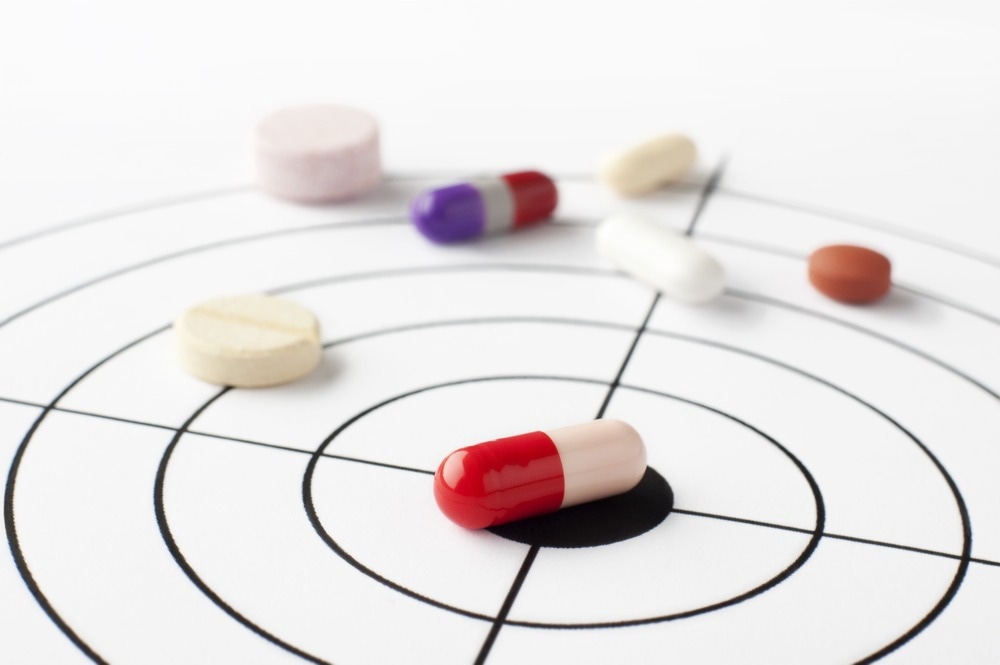Advances in the treatment and prevention of disease rely on novel therapeutics, which are based on innovative drug targets. Scientists dedicate a significant amount of time and money to exploring the new potential targets essential to continuing medical advancements.

Image Credit: George Marcel/Shutterstock.com
While the emergence of ‘biologicals’ has vastly grown the number of potential drug targets, those that are appropriate remain limited. Drug target discovery and assessment of these potential targets is an important part of drug development. Here, we discuss the key properties of a molecule that make it a good drug target and detail the drug target selection process.
Target identification in drug discovery
The first stage of the drug discovery process is target identification. One of the most vital steps to ensuring that a novel therapeutic will be successful is identifying targets that will not only be effective but also not induce serious adverse events. Therefore, it is important to identify appropriate targets and validate these.
A target is an umbrella term referring to a biological entity such as a gene, protein, or RNA section. To be a ‘good’ target, a biological entity must be efficacious and safe, meet various demands (clinical and commercial), and be ‘druggable’. Targets deemed to be ‘druggable’ are accessible to the drug molecule and induce a desired biological response. Effective drug identification and validation allow scientists to confidently select targets that will most likely have a desired biological effect with minimal unwanted side effects. This means that time and money aren’t wasted putting drugs through trials that affect inappropriate drug targets, allowing effective drugs to get to market quickly.
Methods of target identification that are currently in use are mostly those that leverage data mining techniques. Data mining in target identification uses a bioinformatics approach to select targets with appropriate features and prioritizes potential disease targets. Various sources, such as compound profiling data, gene expression data, patent information, proteomics data, publications, and transgenic phenotyping, guide data mining approaches.
In addition, such a[[roaches also examine mRNA/protein levels to correlate the expression of certain mRNA/proteins with specific diseases. Finally, target identification approaches also explore genetic associations; for example, they might look for a link between the risk of a certain disease with a specific genetic polymorphism. These techniques have significantly developed over the years and have allowed target identification to improve significantly.
Continue Reading: The Importance of Discovering New Drugs
Target validation in drug discovery
Once an appropriate drug target has been selected, scientists then must validate it. Validation techniques are vast and encompass in vitro and in vivo techniques, the choice of which is often dictated by the disease and the intended functionality of the drug in development. Often, multiple approaches will be considered (through clinical trials) to gather as much data as necessary to validate the target.

Image Credit: Ico Maker/Shutterstock.com
HIT discovery process
Once a potential novel target has been validated, compound screening assays are developed via hit identification and lead discovery. A ‘hit’ molecule identified in this process can mean many different things depending on the desired therapeutic activity. Several screening paradigms have been developed to identify hit molecules.
High throughput screening (HTS) is one such paradigm that has gained much attention and success in recent years. The paradigm screens the complete compound library directly against a proposed drug target. Sometimes, secondary assays are also required to confirm the site of action of compounds.
The properties of a good drug target
Through years of pharmacological research, scientists have established a set of specific properties desirable in a good drug target. Scientists look for these features when selecting a novel target. These properties are: the target is disease-modifying and/or research has proven its function in the pathophysiology of a particular disease; modulation of the target has reduced importance in their diseases or under physiological conditions; a 3D-structure of the target protein/close homolog is available where the druggability of the target is not obvious – this aids druggability assessment; the target has a favorable ‘assayability’ enabling high throughput screening; the distribution of target expression is not uniform throughout the body; a target/disease-specific biomarker can effectively measure the therapeutic efficacy of interacting with the target; potential safety profile should be predicted as being favorable; IP situation should also be favorable (e.g., no competitors and freedom to operate).
These features are desirable when selecting a good drug target. However, as technological advances continue, this list of properties may evolve as we get better and more efficient at selecting drug targets. Drug target selection will likely continue to improve over the coming years, which will help novel therapeutics reach market approval and help save the lives of thousands, if not millions.
Sources:
- Bakheet, T.M. and Doig, A.J, 2009. Properties and identification of human protein drug targets. Bioinformatics 25(4), pp.451–457. https://pubmed.ncbi.nlm.nih.gov/19164304/
- Gashaw, I., Ellinghaus, P., Sommer, A. and Asadullah, K., 2011. What makes a good drug target?. Drug Discovery Today, 16(23-24), pp.1037-1043. www.sciencedirect.com/science/article/abs/pii/S1359644611002972
- Hughes, J., Rees, S., Kalindjian, S. and Philpott, K., 2011. Principles of early drug discovery. British Journal of Pharmacology, 162(6), pp.1239-1249. https://www.ncbi.nlm.nih.gov/pmc/articles/PMC3058157/
- Overington, J.P. et al., 2006. How many drug targets are there? Nat. Rev. Drug Discov. 5, pp.993–996. https://www.nature.com/articles/nrd2199
Further Reading
Last Updated: Jun 30, 2022